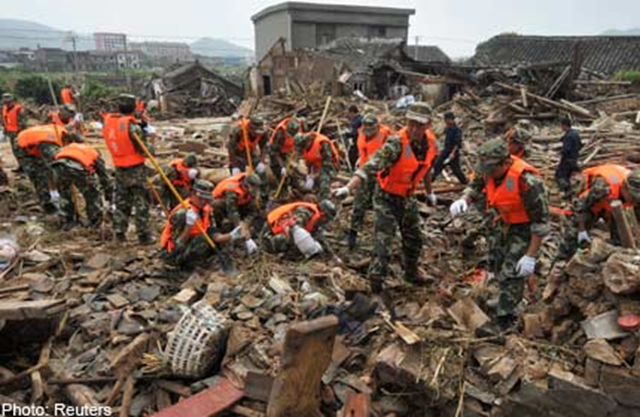Nearly 2 million evacuated as Typhoon Haikui hits China – Reservoir collapse kills at least 10
By Shanghai Newsroom and Kazunori Takada; Editing by Jason Subler and Robert Birsel
8 Aug 2012 SHANGHAI (Reuters) – Typhoon Haikui struck China on Wednesday, packing winds of up to 110 km per hour (68 mph), prompting officials to evacuate nearly 2 million people and grounding hundreds of flights to and from Shanghai and other cities. More than 1.5 million people in the eastern province of Zhejiang and 252,000 residents of outlying parts of Shanghai were evacuated after Haikui landed early in the morning, causing flooding and stranding hundreds of people, the official Xinhua news agency reported. More than 500 domestic and international flights to and from Shanghai’s two airports, Hongqiao and Pudong, have been cancelled as of 10:30 a.m. (0230 GMT), the Shanghai Airport Authority said on its microblogging account. China’s top three carriers – Air China, China Eastern Airlines and China Southern Airlines Co Ltd – have also cancelled all flights to and from Hangzhou and Ningbo, both south of Shanghai, until noon, they said. No ships had been allowed in or out of Shanghai’s ports, the world’s busiest by container volume, since Tuesday night, an official at the Shanghai Water Authority said. […] Haikui forced nearly 270,000 people in the Philippines to flee their homes, prompting authorities to close schools, financial markets and offices.
Nearly 2 million evacuated as Typhoon Haikui hits China 
By Xu Junqian, China Daily / Asia News Network
11 August 2012 CHINA – An 180,000-cubic-meter reservoir in rural Zhoushan, Zhejiang province, collapsed at dawn on Friday, killing at least 10 people and injuring 27 others. The 10 victims killed included six females and four males. Seven of them are older than 74, and one is a 12-year-old child, according to an official statement from the local government. The oldest victim is 87. It also said that at least 80 local families have suffered as a result of the disaster. The collapse – believed by some to be a result of Typhoon Haikui, which brought torrential rain to the area – flooded coastal Shenjiakeng village with water and silt, submerging a large area and damaging at least a third of the homes there. “Most of the houses are made from stones and clay, which was very easily washed away by floods,” said Chen Fu, chief of the Zhoushan firefighting branch, speaking at the site during a phone interview with the local radio station, about six hours after the collapse. Chen said most rescues of the took place within an hour of the collapse. The local government has provided no information about the number of missing people, or the population of the village, or the definite cause of the collapse. “To find the missing is our first priority, and we will spare no efforts to save the injured,” said Zhu Jun, spokesman of Daishan county, which administers the village. Sitting on the north of Zhoushan, the fishing and shipping hub of the highly industrialized Yangtze River Delta, Shenjiakeng village is largely populated by migrant workers from other cities who work at ship-manufacturing companies. Officials said the fact that many migrant workers lived in the village has “added to the difficulties of locating and identifying the missing”. As Typhoon Haikui lashed Zhejiang province on Tuesday and Wednesday, the village was one of the most heavily hit places, receiving 270 mm of rainfall. […] In another development, Typhoon Haikui has left six people dead and forced more than 2.17 million people to be moved in four provincial-level regions in East China, Xinhua News Agency cited the Ministry of Civil Affairs as saying on Friday. In Anhui province, Haikui killed three people and affected nearly 2.17 million residents, as well as destroyed more than 2,400 houses, the ministry said in a report. In Shanghai, the typhoon killed two people and affected 361,000 others, the ministry said, adding that more than 50 houses were destroyed. The typhoon also killed one person and forced 126,000 others to be evacuated in Jiangsu province, as well as forced nearly 1.55 million people in Zhejiang to move, according to the ministry. Haikui, the 11th typhoon of the year, is the third typhoon to hit China’s eastern coast in a week after the storms Saola and Damrey hit the region over the weekend. Though no casualties have been reported in Jiangxi province so far, the Nanchang Railway Bureau said that as the typhoon moved westward, 12 trains running on the Anhui-Jiangxi Railway have been stranded by floods. Work to repair the damage is under way.
